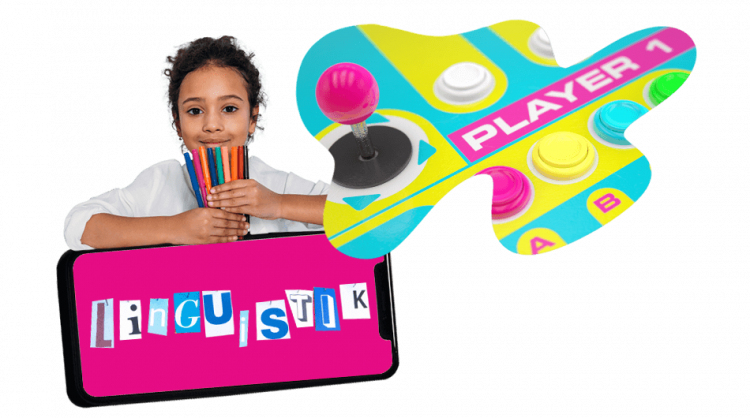By introducing smartphone apps in the virtual classroom, teachers allow for more concentration and participation by their students. Smartphone apps in the virtual classroom not only allow them to learn grammar and vocabulary, but also to enjoy the instant gratification of playing.
One of the drawbacks of online teaching is the need to make sure that your students are paying attention in class. And it is not difficult to imagine that students, especially teenagers, have their smartphones at their fingertips, waiting for the next notification.
- Of course, you can always ask your students to follow the rules and have them put away their phones during class. In my opinion, it is best to make your students aware of the rules early on in the beginning of the online training. This way you will be sure they are not distracted so that they can make the most of the course.
- However, you can approach the use of smartphones from a different angle and try to turn it into an advantage. Using smartphone apps in the virtual classroom to engage students in your online class is a great way to do this.
Basics of smartphone apps in the virtual classroom
In general, using an online platform or an app to teach a foreign language in the virtual classroom is easy. Students can download an app on their phone or they can access the exercises online, and the teacher can demonstrate it using the screen-sharing option.

Each student will then receive their assignment and participate by answering the questions over a given time. The type of actions they need to complete do not require a lengthy explanation; they are often intuitive and allow them to take control of the learning process.
Designing an online exercise doesn’t need to feel like a hassle. You may be required to sign up for a site, and then be guided through the process of creating an online game. Once you post it you will be able to use it multiple times or change parts that are ineffective.
Using smartphone apps in the virtual classroom to teach grammar
One of the straightforward uses of gamification in foreign language teaching is, undoubtedly, to teach grammar. As teachers, we often think of how boring and disengaging grammar exercises may be. While this is true, it is also true is that we can’t work our way around them. So why don’t we just make them more interesting by converting them into a game?
Grammar rules are like rules to games: solve the puzzle, match the pieces, etc. If you add in the factor of time, you now have a game that is ready to be played. Today, gamification has become more and more used in foreign language teaching and learning. It adds the component of emotion into the learning process, while at the same time allows for immediate gratification. Usually, few students are drawn to a course simply by the idea that one day they will reach their objective of using different tenses, words, etc. in a real life situation. And learning grammar just for the sake of it is often not enough, even when you know that in the next activity you will have to use it. So supplementing another, much more immediate goal, is welcome whenever you need to diversify a tedious and boring class.
While a traditional teacher may view this as an unnecessary complication, introducing the concept of a game in class is just another way to make it more engaging. This is essential in virtual classroom teaching and learning.

Often a teacher who is not physically present for their students may realize that they are not paying attention to or getting enough out of the class. Instead of introducing numerous rules to create more discipline, they could think of a way to make the class more interesting and engaging – by introducing games.
Kahoot! is a great application that saves time and resources and which has brought the gaming element to foreign language learning. It has both a free and paid version. If you use the free version you will have access to a few types of quizzes, which are more than enough for a normal foreign language class. The last quiz I created on Kahoot! was about reported speech in French. It is very important to follow correct syntax. The teacher can create sentences that are jumbled, which the students need to put in the correct order. They have a time limit that is normally fixed at 60 seconds. If they can’t answer before times runs out, they lose points.
Of course, you can probably already see that this exercise is not for teaching grammar, but for applying rules that have been already presented. Maybe you will need a few additional exercises before turning to Kahoot!. Nevertheless, it’s worth looking into due to the fact that it brings the emotion of success to your students. If you can imagine how they feel throughout a grammar class, you can say that their emotions range from calm attention to signs of interest while you present the material. Then they are a bit challenged when they start doing the exercises.
Grammar exercises usually lead directly to the first activity where the students have to use what they have learned. This makes grammar like a land that is difficult to cross, and they are just happy to get it over with. But introducing a game element at the end of a grammar lesson will help to finish it in a much more elegant and engaging way. Students will not only feel challenged; they will literally play with the bricks and mortar of language, which is exactly what a language teacher would want from them. This will help them begin to master the most difficult part of any language.
In a project aimed at giving them the reins to the virtual classroom, you can even ask them to prepare a quiz themselves. As I already said, working with Kahoot! is intuitive, easy, and engaging while both creating the activities and when using them in class.
You can use it for vocabulary exercises as well. It allows the user to insert pictures and to associate words with them. This allows the teacher to bypass translation. Often, in foreign language teaching, there is a need to present an object or a concept without translating it. The mother tongue seems to influence teaching in a negative way. Instead of creating a link between the concept and the foreign word for it, translation creates a triangular link by adding the word in the mother tongue. While for some this may prove useful, it is a totally different skill that requires the function of other areas of the brain.

If you found this article useful, you may also like the following articles:
Tech Skills You Should Require Of Your Online Students
Tech Skills For Online Teachers In The Virtual Classroom
Online Training – How to Include Smartphone Apps
